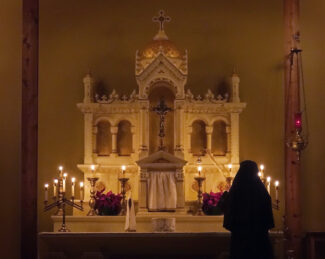
After our parents died, my sister and I knew that our maiden name would not carry on. Since there were just the two of us girls and we both took our husbands’ names when we married, the surname “Arthur” died with my dad. But it wasn’t just the name that we lost with the passing of the older generation. We also lost some family traditions that were important to my parents but less so to my sister and me, like eating peanut butter pie on Christmas day and my dad’s prayer before meals. We even lost a bit of the connection with some cousins that we used to see more regularly when my mom controlled the family social calendar.
Many religious communities are working now to keep this same kind of thing from happening to them. Since the number of religious sisters, priests, and brothers has decreased significantly in recent decades, wise communities of vowed religious are working to ensure that their order’s unique spin on how they live out the Gospel can be passed to future generations through the lay people involved in their sponsored ministries.
RELATED: Why the Sign of the Peace Means Now More Than Ever
That spin has a name, one that is commonly misunderstood: Charism. A charism is defined in some circles as a “special power,” but this conjures up images of snake-handling believers speaking in tongues, which doesn’t quite hit the mark. Others define it as a talent, but in common parlance, we don’t say that a good pianist has a “musical charism” or that an accomplished chef has a “culinary charism.” Still, others define it as a “gift of the Holy Spirit,” which is certainly true and the original meaning of the root word in Greek, but this definition is still a bit too general to be useful.
The Catechism of the Catholic Church defines charisms as “graces of the Holy Spirit which directly or indirectly benefit the Church, ordered as they are to her building up, to the good of men, and to the needs of the world” (Article 799). In everyday language, a charism can be understood as “the gifts from God that allow a person or group to live out the Gospel in relation to the world around them.” In this way, it is the power/talent/gift/grace through which a religious order puts the Gospel into daily practice.
You’d be forgiven for assuming that religious orders are all pretty much the same. Many people do since, after all, they take many of the same vows. But just as your family and mine both celebrate Christmas, we might have very different ways of doing so. Your family might insist on exchanging presents on Christmas Eve before attending midnight Mass. Mine might prioritize the use of an Advent calendar, caroling, and Christmas movie marathons. Both of us honor the feast, but we each have our own spin on it.
Similarly, all Catholic religious orders work to live out the Gospel, but each one does so in its own way. Some emphasize prayer and contemplation while others concentrate on service in the community. Some sponsor ministries in health care while others are devoted to education. Some prioritize long-standing traditional Catholic practices, while others emphasize advocacy and social justice. Each has its own “gifts of the Holy Spirit” that enable them to live out their mission as a religious order in the Church.
Understanding charism in this way is more important today than ever before. Just as I lost family traditions and connections to relatives after my parents died, religious orders are in danger of losing their particular spins on Gospel living now that the future of the ministries they sponsor are run by lay people.
RELATED: 3 Ways to Discover Your Vocation
Although this may sound like bad news, it’s not! At least, it doesn’t have to be. In fact, religious communities have a unique opportunity to nurture – and even elevate – their charism within the ministries that they sponsor. I work at an all-girls Catholic high school sponsored by the Sisters of Mercy. When the school opened in 1955, all the teachers and administrators were religious sisters who lived in the convent attached to the building. But we haven’t had a Sister of Mercy employed as a teacher at our school in more than 20 years.
However, the charism of the Sisters of Mercy is stronger and more visible at our school than it ever was before the advent of lay teachers. That’s because the sisters recognized the need to be very intentional and explicit in teaching their charism to the lay people who began to replace them in their ministries. At my school, everyone from the president and principal down to the newest freshman student can tell you what the core values of the Sisters of Mercy are and what social justice issues they prioritize in their service and advocacy. That was not the case in decades past.
Fortunately, many religious orders have been forward-thinking as they look to the future. They have wisely taken the challenge of declining numbers and turned it into an opportunity to clearly define and communicate their charism. In fact, their example has encouraged me to be more intentional about the family traditions I hope my son will pass on to his children and grandchildren. Sometimes the threat of losing something of value is the very thing that makes it more precious over time.
Originally published May 1, 2019